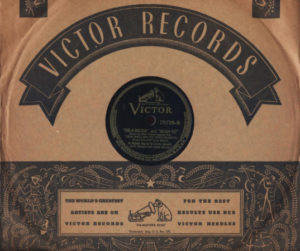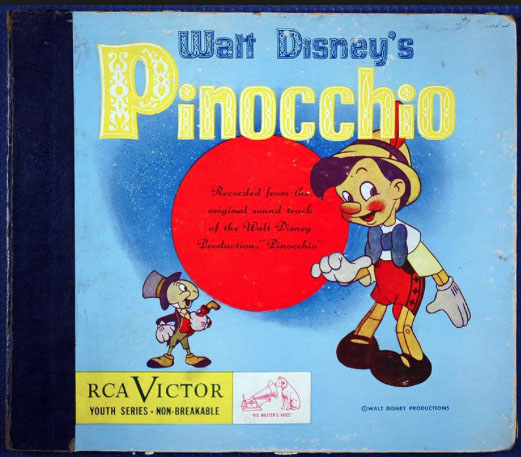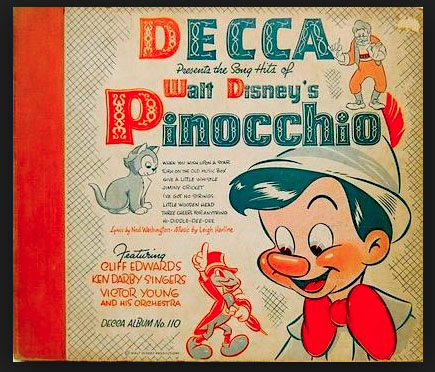By the middle 1920’s, recording techniques had improved so much that records could capture both the grandeur of the Symphony and the delicacy of Chamber Music.
 And, as “serious” music works are often longer than can be put on both sides of a twelve-inch (thirty centimeter) record, somebody came up with. . . the Album: a “book” of from two to twelve records which encompass an entire symphony, concerto, sonata, or tone poem.
And, as “serious” music works are often longer than can be put on both sides of a twelve-inch (thirty centimeter) record, somebody came up with. . . the Album: a “book” of from two to twelve records which encompass an entire symphony, concerto, sonata, or tone poem.
“Popular” albums were later in coming. The earliest such “albums” were eiher devoted to a particular show (such as “Show Boat”), or were devised as tributes to a deceased jazz artist (Bix Beiderbecke or Bessie Smith).
When Victor issued the three consecutively-numbered discs from the soundtrack of Snow White And The Seven Dwarfs, they may not have been thinking “album” per se. (Later, this set would be packaged as a formal album.)
Enter Pinocchio.
Victor had the deal with Disney–so Victor issued a three-disc album (set P 18), with six selections from the sound track of “Pinocchio”. These were dubbed at Victor’s studios in Hollywood, and featured not only the well-known Cliff Edwards (in the role of “Jiminy Cricket”), but Broadway veteran Walter Catlett as J. Worthington Foulfellow, along with Dickie Jones in the title role.
But it turned out that Victor would have some competition for the hard-earned dollars of those who wanted the “Pinocchio” music and songs in a nice, neat package.

Decca Records–an upstart company that had burst upon the record scene back in 1934–was really making a go of popular albums, an not just collections from a show, either.
Nearly all manner of middle-brow “popular” music was coming out on Decca album compilations.
They had already recorded sets drawn from the scores of The Wizard Of Oz and Gulliver’s Travels, when they decided to give the same treatment to Pinocchio.
While Victor’s album was a three-disc set (probably selling for three dollars), Decca’s set was a four-disc set–and it sold for less. (It’s possible that it may have been pegged as low as $1.90.)

People who bought the Decca set certainly got value for money–even if the Victor surfaces wore better under the needle than Decca’s.
Victor Young organized the best studio musicians that Local 47, American Federation of Musicians, could offer. Ken Darby handled the chorus work, and with his usual aplomb.
And the Decca set offered someone who was also on the Victor issue of soundtrack rubbings. That someone was Cliff Edwards.
Space does not permit a full bio of “Ukulele Ike” here. But “Pinocchio” was his first work for Disney.
And the relationship would continue and thrive into the middle 1950’s, to their mutual benefit.
The discs in the Victor album were issued in England on HMV–sporting pale blue labels with appropriate illustrations on the label, and,again, with Nipper relegated to a small canton near the bottom of the label.
NEXT WEEK: It’s Different with the Classics


 James Parten has overcome a congenital visual disability to be acknowledged as an expert on the early history of recorded sound. He has a Broadcasting Certificate (Radio Option) from Los Angeles Valley College, class of 1999. He has also been a fan of animated cartoons since childhood.
James Parten has overcome a congenital visual disability to be acknowledged as an expert on the early history of recorded sound. He has a Broadcasting Certificate (Radio Option) from Los Angeles Valley College, class of 1999. He has also been a fan of animated cartoons since childhood.











































One small correction, it’s Walter Catlett, not Catless.
Thanks for catching that typo. It’s been corrected.
I’m familiar with the Decca PINOCCHIO because it wound up on one side of a Decca LP I had in my childhood record collection. (Decca’s WIZARD OF OZ album was on the other side.) That OZ/PINOCCHIO album turned out to be a durable catalog item. It survived the transition from Decca to MCA and remained in print to the end of the LP era.
Regarding the original Decca and Victor 78 rpm albums, I would be very surprised if the Decca didn’t sell better. Looking through old newspapers, retailers tended to advertise the two albums together, with the Decca always the cheaper of the two. Granted, the Victor had the original soundtrack performances and was a fancier package, but the ads tended not to mention either of those two things. Just “Walt Disney’s Pinocchio” on Decca and on Victor, with the Decca priced for around two bucks while the Victor was approximately a dollar more.
That Decca set is sitting in my house right now – or part of it anyway; only three of the four discs survive. Presumably my family bought the album when it was first released. I remember playing it as a kid in the mid-1950s on our 1939 Zenith radio-phono, which by then had been exiled from the living room to the upstairs hallway after that upstart home entertainment system called TV arrived at our house in 1952. Actually, the Pinocchio set now resides in one of the record compartments of that same Zenith, which I also have but dare not plug in anymore.